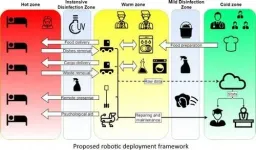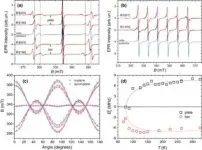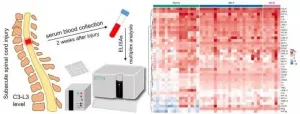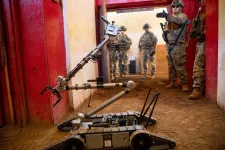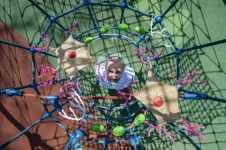(Press-News.org) In December 2019, a new viral infection was detected in Wuhan, China. On January 30, 2020, the World Health Organization declared the outbreak a public health emergency of international concern, and on March 11, the COVID-19 pandemic. In light of the danger that the infection poses to human personnel, the idea to utilize automation in hospitals is one of the natural solutions in healthcare.
Among the paper's five co-authors, four are working in robotics and one is an expert in medicine. The paper presents a new concept of an infectious hospital that may become a worldwide standard in the future. The idea of this appeared while the authors were witnessing a quick spread of the Covid-19 and non-systematic attempts of most technologically developed countries of Europe, Asia, and America to employ various robots in their reaction to this disaster.
The team comprises Evgeni Magid (Professor, Head of Intelligent Robotics Systems Lab), Aufar Zakiev (PhD student, Research Associate of the same lab), Tatyana Tsoy (PhD student, Research Associate of the same lab), Roman Lavrenov (Senior Lecturer, Institute of IT and Intelligent Systems), and Albert Rizvanov (Professor, Academician of the Tatarstan Academy of Science, Director of the Center for Precision and Regenerative Medicine).
Initially, the authors surveyed pandemics-related research papers that consider pandemic mitigation from IT, AI, and robotics standpoints. During this analysis, they discovered that most of existing papers about applying robotics for COVID-19 mitigation are surveys which just enumerate existing solutions, or, conversely, present a single technique or a few techniques in a point-wise manner. They went further and, based on the performed survey, proposed a new classification of robots with regards to their usage for pandemic needs (originally intended and adapted robots) and a new classification of such robots with regards to a required operator training.
The most important contribution of the paper is a novel holistic architecture of an infectious disease hospital that employs robotic tools, both existing ones and proposed future technologies. This holistic architecture could help to develop robots with practical applicability and allows designers to define their functions precisely.
The new infectious hospital framework preserves classical organizational structure of "hot", "warm" and "cold" zones. The hot zone is the epicenter, which is the most dangerous location of a direct contact with infected patients that have confirmed cases of a disease; this zone has strong restrictions aimed at containing the infection strictly inside the zone. The warm zone contains medical facilities with indirect contact with an infection, e.g., medical wards, laboratory areas, blood banks, dietary and laundry services, personnel restrooms for short breaks, etc. Finally, the cold zone is a safe zone that includes places with a low risk of infection.
The researchers analyzed possible daily activities within the three zones and selected a number of tasks, mainly within the hot zone, which could be successfully performed by robots. Moreover, the initial survey analysis demonstrated that for many of these tasks, there already exist at least several robotic solutions. Therefore, a proposed precise definition of functions that could be performed by robots in an infectious hospital environment aims to help hospital managers to select proper solutions, which will make the hospital operation more efficient and safe for medical personnel. On the other hand, the proposed requirements for infectious hospital robots should help robotic companies to develop highly sought products. In addition, the paper discusses ethical issues of robotics applications, which should be taken seriously both by robot developers and decision-making customers (e.g., hospital managers); the former should ensure ethical guidelines of human-robot interaction and task-oriented strategies before manufacturing the product, and the latter should be aware of potential ethical conflicts while selecting particular products for particular tasks.
Robotics has a huge potential almost in every field of our life. The authors strongly believe that robots should gradually replace human personnel within a dangerous hot zone of an infectious hospital and perform routine tasks which do not require high-level medical skills or education. This can increase the safety of doctors and other medical staff, decrease the unnecessary physical and psychological burden, and partially close the existing shortage of medical personnel that was widely reported even before the beginning of the pandemic. The paper proposes not only a new architecture for an infectious hospital, but also a variety of particular tasks and practical recommendations of further robot integration.
In the future, the team plans to develop the proposed infectious hospital framework and to evaluate its practical application. Even for running such hospital within a simulation, a large amount of preliminary work should be performed, including development of new regulations, communication and control strategies, sensory data fusion and autonomous navigation algorithms, safe and ethical human-robot interaction strategies and dozens of other tasks. This is a huge-scale and long term multidisciplinary project that requires international collaboration and significant funding. National governments and the humankind in general have learned important lessons from the COVID-19 pandemic and, should this project receive support, we may be better prepared for another pandemic - which is happening sooner or later.
INFORMATION:
While studying strontium titanate with electron paramagnetic resonance, a team from KFU's Center for Quantum Technology has found that the shape of a specimen of strontium titanate influences its internal symmetry. The research was co-conducted by the Ioffe Institute of Physics and Technology (Russia) and the Institute of Physics of the Czech Academy of Sciences.
At room temperature, SrTiO3 is a crystal with high cubic symmetry, that is, the lattice of strontium titanate, like bricks, is composed of unit cells, each of which is a regular cube. However, the researchers showed the picture is a bit more nuanced. In ...
The research is conducted by Kazan University's Open Lab Gene and Cell Technologies (Center for Precision and Regenerative Medicine, Institute of Fundamental Medicine and Biology) and Republic Clinical Hospital of Kazan. Lead Research Associate Yana Mukhamedshina serves as project head.
Spinal cord injury mechanisms include primary and secondary injury factors. Primary injury is mechanical damage to the nervous tissue and vasculature with immediate cell death and hemorrhage. Secondary damage leads to significant destructive changes in the nervous tissue due to the development of excitotoxicity, death ...
The project was kickstarted in 2017 when a delegation of YTC America (subsidiary of Yazaki Corporation) visited Kazan Federal University. During the talks, YTC suggested that KFU participate in developing effective methods of separating single-wall carbon nanotubes (SWCNTs) into metallic and semiconducting specimens. This was to be done on Tuball tubes produced by OCSiAl, since they are the only ones currently available in industrial quantities.
Carbon nanotubes (CNT) is a family of 1D nanostructures with numerous verified applications, made possible due to their ...
A recent study finds that social inequality persists, regardless of educational achievement - particularly for men.
"Education is not the equalizer that many people think it is," says Anna Manzoni, author of the study and an associate professor of sociology at North Carolina State University.
The study aimed to determine the extent to which a parent's social status gives an advantage to their children. The research used the educational achievements of parents as a proxy for social status, and looked at the earnings of adult children as a proxy for professional success.
To ...
ADELPHI, Md. -- Spoken dialogue is the most natural way for people to interact with complex autonomous agents such as robots. Future Army operational environments will require technology that allows artificial intelligent agents to understand and carry out commands and interact with them as teammates.
Researchers from the U.S. Army Combat Capabilities Development Command, known as DEVCOM, Army Research Laboratory and the University of Southern California's Institute for Creative Technologies, a Department of Defense-sponsored University Affiliated Research Center, created an approach to flexibly interpret and respond to Soldier intent derived from spoken dialogue with autonomous systems.
This technology is currently the primary ...
The Andes Mountains of South America are the most species-rich biodiversity hotspot for plant and vertebrate species in the world. But the forest that climbs up this mountain range provides another important service to humanity.
Andean forests are helping to protect the planet by acting as a carbon sink, absorbing carbon dioxide and keeping some of this climate-altering gas out of circulation, according to new research published in Nature Communications.
The study -- which draws upon two decades of data from 119 forest-monitoring plots in Colombia, Ecuador, Peru, Bolivia and Argentina -- was produced by an international team of scientists including researchers supported by the Living Earth Collaborative at Washington University in St. Louis. The lead author was Alvaro Duque from the ...
A team of scientists from Russia studied the role of double-stranded fragments of the maturing RNA and showed that the interaction between distant parts of the RNA can regulate gene expression. The research was published in Nature Communications.
At school, we learn that DNA is double-stranded and RNA is single-stranded, but that is not entirely true. Scientists have encountered many cases of RNA forming a double-stranded (a.k.a. secondary) structure that plays an important role in the functioning of RNA molecules. These structures are involved in the regulation of gene expression, where the double-stranded regions typically carry specific functions and, if lost, may cause severe disorders. A double-stranded structure is created by sticky complementary ...
New, detailed study of the Renland Ice Cap offers the possibility of modelling other smaller ice caps and glaciers with significantly greater accuracy than hitherto. The study combined airborne radar data to determine the thickness of the ice cap with on-site measurements of the thickness of the ice cap and satellite data. Researchers from the Niels Bohr Institute - University of Copenhagen gathered the data from the ice cap in 2015, and this work has now come to fruition in the form of more exact predictions of local climate conditions.
The accuracy ...
A new study led by researchers at Johns Hopkins and the University of Pennsylvania uses computer modeling to suggest that eviction bans authorized during the COVID-19 pandemic reduced the infection rate and not only protected those who would have lost their housing but also entire communities from the spread of infections.
With widespread job loss in the U.S. during the pandemic, many state and local governments temporarily halted evictions last spring, and just as these protections were about to expire in September, the Centers for Disease Control ...
Alzheimer's disease (AD) is a form of progressive dementia interfering with daily living. It is caused by the decline in the number of brain cells resulting in the deterioration of our mental abilities. One of the main reasons for the worsening brain cells condition and even the brain shrinkage are molecules having a specific structure called β-amyloids (Aβ). They are peptides that tend to agglomerate around the nerve cells, becoming toxic and damage them. Recent studies, presented by scientists from the Institute of Physical Chemistry, Polish Academy of Sciences, led by dr. Piotr Pieta, give hope for inhibition of the β-amyloids' toxicity by applying the K162 molecule. Researchers present a tremendous protective impact on the biological membranes ...
